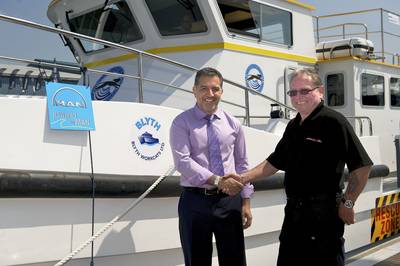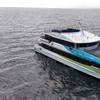Wildcat Takes Delivery of Blyth 17m Workcat
Windfarm support company Wildcat Marine has taken delivery of the first 17-metre Blyth Workcat.
The new boat was handed-over in Southampton, UK, and is now based in Barrow in Furness from where it is currently providing support services for the Walney Wind Farm. The new boat, “Wildcat 3”, is the largest catamaran ever built by Blyth Workcats and the company is confident that it will introduce a new standard of performance and economy for the wind farm support industry.
The new 17-metre boat is the third Blyth Workcat to be owned by Wildcat Marine. The company began supporting wind farm operators in 2008 with an 11-metre Blyth Workcat. This was followed by a 14-metre Workcat and the company is now confident that the new 17-metre will surpass the performance and economy of its predecessors.
“These boats are very capable,” said Rob Benson, co-owner of Wildcat Marine. “The new 17-metre is still proving itself but from what we have seen so far I believe that we have acquired an exceptional boat in its class. It is always a gamble being the first buyer of a new boat, especially as it is a completely different design to the other models but I think we have chosen a winner,” he said. “It is the fuel economy of the Blyth 17-metre that is a major plus,” said Rob Benson. “At its cruising speed of 20 knots it uses very little fuel. It is also so smooth and quiet that it is better than we could have ever expected.”
The boat is powered by two MAN D2848, 750hp engines and the fuel consumption predictions made by the manufacturer have now been confirmed at 130 litres per hour per engine at maximum speed of 26+ knots and 75 litres per hour at cruising speed of 20 knots. This will be seen as a major operating cost benefit by clients especially when combined with its ability to carry 12 passengers and two crew in comfort along with six tonnes of cargo to offshore work locations at a cruising speed of over 20 knots.
“Wildcat 3” also incorporates a number of design modifications specified by Wildcat Marine that are aimed to increase its efficiency as a wind farm support vessel. These include bow thrusters for increased manoeuvrability and helm stations on either side of the main deck and close to the rescue zone. “These make berthing easier by giving the skipper exceptional visibility while enabling him to provide more support for the deck crew.” explained Rob Benson. “The only way this boat could have been better would have been if it had been free,” he joked in conclusion.
Blyth Workcats have been built at the company’s yard on Canvey Island, Essex, UK, for nearly 30 years. The new Blyth 17-metre joins a range consisting of 10, 11, 12 and 14-metre catamarans that are built for wind farm support, surveying, dive support, passenger ferry, fishing charter or any of a wide range of workboat tasks. All Workcats are built from GRP using the single mould principle under meticulous quality control. Besides being less costly than metal hulls, the GRP construction also enables boats to be built with additional strength where it is needed while valuable weight savings can be made in other areas wherever the design permits it.















